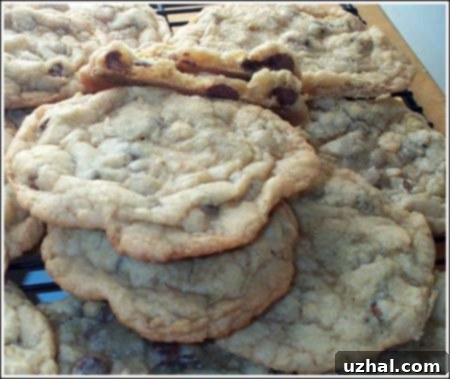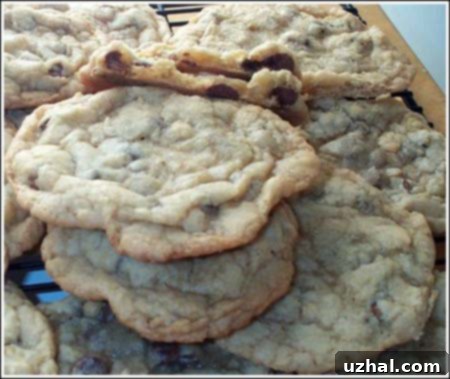Rob’s Radical Chocolate Chip Cookies: A Detailed Recipe Review and Essential Baking Tips
The world of chocolate chip cookies is vast and endlessly debated, with every baker possessing their own cherished recipe or unique twist. Recently, my friend Valerie, an avid home baker, embarked on a quest to tackle another contender from our “Showdown list” of popular cookie recipes. Her mission? To thoroughly test and review Rob’s Radical Chocolate Chip Cookies. After running a few errands, I returned home to find a delightful surprise in my inbox: Valerie’s comprehensive email detailing her experience, complete with honest feedback and insightful observations. This wasn’t just another cookie review; it was a deep dive into the nuances of a recipe that promised something “radical.”
Initial Impressions and Ingredient Scrutiny: Milk Chocolate & Baker’s Sugar
Before Valerie even preheated her oven, the recipe immediately presented two points of contention that gave both of us pause. The first, and perhaps most significant, was the call for milk chocolate. For many chocolate chip cookie purists, including Valerie and myself, milk chocolate is an unconventional choice. We typically gravitate towards the richer, more complex profiles of semi-sweet or dark chocolate, which provide a welcome counterpoint to the sweetness of the cookie dough itself. Milk chocolate, while delicious in its own right, often brings an added layer of sweetness that can, at times, overwhelm the delicate balance of a classic chocolate chip cookie. Our initial thought was that this ingredient choice might lead to an overly sweet result, potentially masking other flavors.
The second ingredient that caught our attention was “Baker’s Sugar.” This term isn’t as commonly found in everyday home baking recipes, prompting us to do a quick bit of research. As it turns out, Baker’s Sugar is simply superfine sugar, also known as caster sugar in some regions. This type of sugar has finer granules than standard granulated sugar, which allows it to dissolve more quickly into doughs and batters. The benefit of this rapid dissolution can be a smoother texture and a more even distribution of sweetness throughout the cookie. Valerie, being well-prepared, went ahead and used superfine sugar as specified. For my own eventual attempt, I plan to mimic this by giving regular granulated sugar a quick blitz in the food processor to achieve a similar fine consistency, a common hack for those without superfine sugar on hand.
Valerie’s Baking Journey: From Doubt to Delight
Despite our initial reservations about the milk chocolate, Valerie approached the recipe with an open mind and her usual meticulous attention to detail. She prepared the dough, making sure to adhere to the instructions while also incorporating her own standard baking practices. One such practice, which often yields excellent results, was chilling the dough. Many bakers swear by chilling cookie dough for at least 30 minutes, or even overnight, as it helps solidify the fats, prevents excessive spreading, and allows the flavors to meld more deeply. Valerie also noted a peculiar instruction in the recipe: to “flatten slightly” the cookie dough balls before baking. Given that cookies often spread on their own, this instruction seemed counter-intuitive, especially if one desired a thicker cookie. Deciding to observe the dough’s natural behavior, Valerie opted not to flatten her cookies at all.
Her baking process followed, and soon her kitchen was filled with that unmistakable, comforting aroma of freshly baked chocolate chip cookies. The anticipation built as she pulled the trays from the oven, eager to see how Rob’s “radical” take on the classic would turn out.
(Photo courtesy of Valerie)

The End Result: Valerie’s Detailed Feedback
Upon cooling, Valerie immediately dove into tasting and evaluating the cookies. Her notes were incredibly detailed, offering a comprehensive look at what worked well and what could be improved. The overall verdict? “Very good cookies.” This was a pleasant surprise, especially considering our initial skepticism. However, her feedback came with important caveats and suggestions for modification. Here’s a breakdown of her observations:
Texture: A Masterpiece of Contrasts
Valerie absolutely raved about the texture, describing it as “love the texture — really crispy/buttery on the outside with chewy middles. Nice and bumpy cookies.” This particular combination of textures – a crisp exterior giving way to a soft, chewy interior – is often considered the holy grail of chocolate chip cookies. It speaks to a well-balanced recipe where the fats, sugars, and leavening agents work in harmony. The “bumpy” appearance further suggests a rustic, homemade quality, which is always appealing. This textural success is a huge win for Rob’s recipe and highlights its potential.
Flatness: An Unexpected Spread
Despite the excellent texture, Valerie noted that the cookies came out “pretty flat.” She elaborated, “I have a feeling they aren’t supposed to be that flat since he says to flatten slightly going into the oven. I didn’t flatten at all and in fact I chilled the dough, but they still came out fairly flat. Ok, not THIN, but just not thick.” This observation is quite interesting. Cookies can spread for various reasons: warm butter, insufficient flour, too much leavening, or even a higher sugar-to-flour ratio. The fact that they spread even after chilling the dough (which typically helps prevent spreading) suggests the recipe might naturally yield flatter cookies. The instruction to “flatten slightly” then becomes even more puzzling; perhaps it’s intended to encourage a more even spread rather than to achieve a specific thickness. For those who prefer a thicker, puffier cookie, this might be an area for experimentation, perhaps by adding a touch more flour or slightly reducing the butter.
Taste & Sweetness: A Balancing Act
Regarding taste, Valerie found the cookies to be “very good, but pretty sweet.” This aligns perfectly with our initial concerns about the milk chocolate. While delicious, milk chocolate typically contains a higher sugar content than semi-sweet or dark chocolate, which, when combined with the sugar already in the dough, can lead to a pronounced sweetness. Her recommendation was clear: “definitely go with the semisweet or dark chocolate for some of the cookies.” This modification would introduce a depth of flavor and a bitterness that would beautifully cut through the sweetness, creating a more balanced and complex taste profile.
The Critical Role of Salt: Enhancing and Counteracting
Perhaps Valerie’s most emphatic suggestion was to “add a bit more salt.” She even noted her own attempts: “actually, I DID use a rounded teaspoon instead of the ¾ teaspoon and I used salted butter and I still thought it could use a bit more…. I think that is because I was tasting so much sweet that I couldn’t taste the salt as much?” This insight underscores the crucial role of salt in baking, especially in sweet recipes. Salt isn’t just for making things salty; it’s a flavor enhancer that brightens other notes and, most importantly in this context, helps to balance and temper sweetness. When a recipe is very sweet, more salt is often needed to prevent it from becoming cloying. Valerie’s experience suggests that even with an increased amount and salted butter, the cookies were still overwhelmingly sweet, indicating a need for a more substantial salt boost to achieve equilibrium. Her ultimate conclusion regarding taste was concise and actionable: “I would just up the salt and nix the milk choc.”
My Future Baking Plan: Adapting Rob’s Radical Recipe
Valerie’s detailed notes have not only piqued my interest but also provided a clear roadmap for my own attempt at Rob’s Radical Chocolate Chip Cookies. Based on her experience, here’s how I plan to approach the recipe:
- Chocolate Choice: I will definitely swap out the milk chocolate for a high-quality semi-sweet or a blend of semi-sweet and dark chocolate chips. This will introduce more complexity and temper the sweetness significantly.
- Salt Content: I will be generous with the salt, likely starting with 1 to 1.25 teaspoons of fine sea salt, even if using unsalted butter. If using salted butter, I will still add extra salt, perhaps around ¾ to 1 teaspoon, adjusting to taste. The goal is to achieve that perfect balance where the salt enhances the chocolate and sugar without becoming overtly noticeable.
- Baker’s Sugar: I’ll follow Valerie’s lead and use superfine sugar, either store-bought or by quickly processing granulated sugar to a finer consistency. I’m keen to see if this contributes to the excellent texture Valerie described.
- Flattening: I will also skip the “flatten slightly” step, trusting the dough to spread naturally, and aim for a slightly thicker cookie if possible by potentially increasing the flour by a tablespoon or two if the dough seems too loose.
- Chilling: I will definitely chill the dough for at least an hour, or even overnight, to further develop flavors and minimize spread.
Beyond the Recipe: General Tips for Perfect Chocolate Chip Cookies
Valerie’s adventure with Rob’s cookies offers valuable lessons that extend to all chocolate chip cookie endeavors. Here are some general tips to help you bake your best batch yet:
1. Understand Your Sugar
Different sugars play different roles. Granulated sugar promotes crispness and spread, while brown sugar adds chewiness, moisture, and a subtle caramel flavor. Superfine sugar (Baker’s Sugar) dissolves quickly, leading to a smoother, often more uniform texture. Experiment with different ratios or types to achieve your desired texture.
2. The Power of Quality Chocolate
The type and quality of your chocolate make a huge difference. Milk chocolate adds sweetness, semi-sweet offers a balanced flavor, and dark chocolate provides richness and depth. Use a good quality chocolate that you enjoy eating on its own. Don’t be afraid to mix varieties!
3. Don’t Skimp on the Salt
Salt is not just for savory dishes. In sweet baking, it’s a flavor enhancer that cuts through richness and balances sweetness. A pinch of salt can transform a good cookie into a great one. If your cookies taste flat or overly sweet, more salt is often the answer. Fine sea salt or kosher salt are excellent choices.
4. Butter Temperature Matters
Most recipes call for room temperature butter, meaning it’s soft enough to indent but still cool. Overly soft or melted butter can lead to cookies that spread too much and become greasy. Cold butter can result in a crumbly dough that doesn’t cream well with sugar.
5. The Magic of Chilling Dough
Chilling cookie dough for at least 30 minutes, or even up to 72 hours, is a game-changer. It allows the flour to fully hydrate, the flavors to meld, and the butter to firm up. This results in less spreading, chewier cookies, and a more developed flavor profile.
6. Don’t Overmix
Once you add the dry ingredients to the wet, mix until just combined. Overmixing develops the gluten in the flour, leading to tougher, less tender cookies.
7. Proper Baking Temperature and Time
Ensure your oven is preheated to the correct temperature. An oven thermometer can be incredibly helpful for accuracy. Bake until the edges are golden brown but the centers still look slightly soft. Cookies continue to set as they cool on the baking sheet.
Conclusion: A Radical Recipe with Room for Personalization
Valerie’s test of Rob’s Radical Chocolate Chip Cookies proved to be an enlightening experience. While the recipe delivers an undeniably fantastic texture – that coveted crispy exterior and chewy interior – its default sweetness level, largely due to the milk chocolate, might not appeal to everyone. However, this is precisely where the “radical” aspect of baking truly comes into play: the freedom to personalize and adapt. By making simple adjustments like swapping the chocolate and increasing the salt, this recipe has the potential to become a true standout. It serves as a wonderful reminder that even the most acclaimed recipes can be a starting point for culinary creativity, encouraging us to listen to our palates and tailor our bakes to perfection. I’m excited to try my hand at these cookies, armed with Valerie’s invaluable feedback, and look forward to sharing my own results soon!
